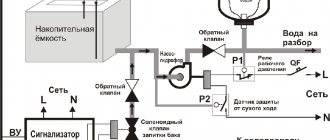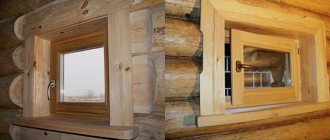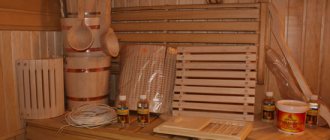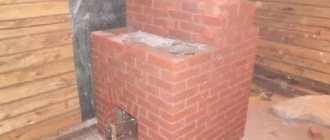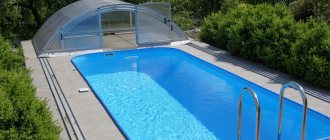Installing a water tank in a bathhouse opens up a number of conveniences and advantages for the owner. Firstly, it becomes possible to prepare hot water while firing the furnace, which allows you to save energy resources and use them as efficiently as possible. Secondly, the use of such a unit in most cases makes it possible to refuse to install an electric water heater, which also benefits the budget allocated for the arrangement of the bathhouse.
How to make a stainless steel water tank for a bath
There are several basic requirements for water tanks: they must be spacious, durable, warm up in the shortest possible time and retain heat for as long as the needs of steam room visitors dictate. Among the options available to the average user, products made of stainless steel best meet the listed criteria.
Stove with a tank on a pipe
Sauna stove Varvara classic with a hanging water tank
Next, you are invited to familiarize yourself with the key features of water tanks made of stainless steel, as well as study the manuals for self-assembly and installation of such structures.
Diagram - example of installing a remote water tank
TOP 5 best water tanks for baths
| Photo | Name | Rating | Price | |
| #1 | Teplodar Parus | ⭐ 99 / 100 2 — votes | Find out the price | |
| #2 | Ferrum | ⭐ 98 / 100 | Find out the price | |
| #3 | MetalStroy | ⭐ 97 / 100 4 — votes | Find out the price | |
| #4 | Volcano | ⭐ 96 / 100 1 — vote | Find out the price | |
| #5 | Horizontal | ⭐ 95 / 100 4 — votes | Find out the price |
Which water tank would you choose or recommend?
Take the survey
Selecting the optimal tank volume
An equally important task is to determine the appropriate tank volume. The calculation of this parameter should be carried out taking into account the rate of water consumption per adult for bathing procedures, which ranges from 18 to 26 liters of water.
For a family of 2 people, it is enough to purchase a 50-liter tank, for a holiday with a group of 4 to 6 people - a 100-liter tank.
Factory models of water heating devices are presented in a wide range of volumes - from 20 to 200 liters. Electric boilers also have different volumes - from 30 to 100 liters.
Types of tanks
Water tanks of different configurations are installed. The method of heating water may also differ. When choosing a container, you should take into account all the nuances.
The purpose of the hot water tank in the bathhouse
Capacity
The volume of the installed tank depends on the number of people who can simultaneously be in the bathhouse and use hot water. On average, 10...20 liters of boiling water should be provided for each person (with a small reserve). Today, tanks with a volume of 50...100 liters are produced. As a rule, it is not advisable to install a tank with a capacity exceeding 100 liters.
The shape of the container can be any: square, rectangular, oval and even round products are produced. But first of all you need to pay attention not to this, but to the build quality of the tank and the manufacturer’s warranty.
The shape of the container can be any
Material
When choosing a container, you need to consider that it must be able to withstand high temperatures (up to 250 degrees) for a long time.
Metal tank for water in the bath
You should not try to save money and install tanks made of ferrous metals. This approach cannot be justified not from an aesthetic point of view, but mainly from practical reasons. Due to constant exposure to high temperatures, the metal will deform over time , and traces of corrosion will appear on it . This significantly reduces the service life of the tanks and the quality of the water in them.
- The most common tank option is stainless steel construction. The demand for such tanks is explained by their attractive appearance, durability, resistance to various types of external influences, high heating rate, ability to retain heat for a long time, relatively low weight, hygiene, high durability and ease of maintenance. The tank configuration may vary. But high-quality stainless steel costs a lot. And you need to take into account that today there are many counterfeit products on offer, which will soon rust.
Stainless steel tank for bath - Not so common, but there are tanks made of cast iron. They are not afraid of rust. However, it must be borne in mind that, despite the fact that the water in such structures will not cool quickly, it takes more time to heat it up. Due to the bulkiness of the tanks, you need to carefully consider their location. Today, not many companies produce cast iron tanks, and they are not very cheap.
Cast iron water tank for bathhouse - Enameled containers can be used, but they are not the best option.. Of course, such material does not corrode and is very hygienic. But low resistance to mechanical damage over time will inevitably lead to the fact that the metal with a fairly thin coating will become chipped (as a result of not very careful handling) and these areas will rust. It will no longer be possible to fix the problem.
Enameled container for water in the bath
Stainless steel tanks can be considered the optimal design option for installation in a bathhouse. If we talk about the type of steel, it is recommended to choose products made from AISI 304. It contains not only chromium, but also nickel, which increases the durability and reliability of the material.
Prices for a water tank in a bathhouse
water tank for bath
Location and design
Three methods are used to place the tank: traditional (directly near the firebox), on the chimney and remote . What is the difference?
Bath stove with tank
Tank built into the oven
The reservoir can be located on the side or above the firebox. The water in it heats up quite quickly (exposed to open fire). To drain it, a ball valve is installed. Of course, this design does not involve pipeline laying work, which saves labor and material resources. However, using such a container is not very convenient; usually a tank of not very large capacity is installed, and its installation takes up useful space in the steam room, which usually is not very much. The best solution in small-sized baths is the top location of the tank. Since the metal will be in direct contact with the fire, the thickness of the tank walls must be at least 8 mm.
Water tank next to metal firebox
Reservoir on a pipe
If the ceiling height allows, you can install the tank on the chimney. Water is heated by hot gases passing through it. To simplify the installation process, it is possible to purchase a container with built-in chimney elbows. This tank can be fixed without much effort. By laying a pipeline from the tank, you can carry water to any point in the bathhouse, for which a pipe is connected to the bottom of the tank, ensuring the flow of liquid, for example, into the shower. Filling a tank installed in this way is not very easy due to the high location of the filler hole. It is best to use a hose lowered into a container for these purposes.
Reservoir on a pipe
Remote design
Thanks to the installation of a heat exchanger on the heater (on the chimney or directly on the stove) and natural convection, it is possible to place the tank in the washing compartment.
Water tank over brick firebox
The heat exchanger can be integrated into the oven (removable or non-removable), but you can easily install it yourself. It is a coil or container with a volume of several liters with pipes to create a circuit.
What to use as fuel material
Dry wood is the best material for heating a heater. True, different types of wood have different calorific values. Thus, beech wood needs to be burned approximately 15% less than birch wood to produce the same amount of heat.
What should not be burned in a stove:
- Plastic, coal, briquettes, granules,
- Construction waste, wood with paint, sleepers,
- Rags, leather, rubber, diapers,
- Garden waste.
Some customers install a special gas-wood-burning stove in a barrel sauna. In this case, gas can be used as fuel.
How does the system work?
Heat from the stove is transferred to the register or water jacket of the heat exchanger, which leads to an increase in the temperature of the coolant. Since the water in the tank has a lower temperature, pressure is created that promotes gravity flow of the liquid. Thus, hot water enters the tank, and cold water enters the heat exchanger through a pipeline, where it is heated (from the bottom point of the tank, water should be supplied to the bottom point of the heat exchanger, and from the top point of the heat exchanger, water should accordingly go to the top point of the tank). The minimum pipe diameter is 3/4 inch. The process continues until the temperature in the oven drops.
How to connect the water tank
Important! The tank must be higher than the heat exchanger, otherwise water circulation will not be ensured.
Without installing a pump, the total length of the pipes between the heat exchanger and the remote tank should not be more than 3 m. There is also a nuance in the principle of the pipeline design. It is necessary to create a slope to ensure natural circulation of the coolant: the pipes connecting the heat exchanger to the tank must have a slope of at least 25...30 degrees, and those delivering water from the heat exchanger to the tank must have a slope of at least 250 degrees.
Installing a heat exchanger allows you not only to do without a water heater in the tank, but also to transfer heat to all rooms.
DIY sauna tank
The heat exchanger must be chosen wisely. It should not reduce the performance of the heater by taking away a significant amount of heat from it. The maximum that it can take is 10% of the generated thermal energy.
If it is not possible to organize the movement of water by gravity, you can supplement the system with a circulation pump. This will increase its effectiveness. It will be possible to increase the length of the pipeline and reduce the slope. But the operation of this equipment is only possible from a 220 V electrical network.
Circulation pump pressure calculator
Go to calculations
Important! When operating water supply systems, remember that it is forbidden to heat the heater if the tank is empty. Otherwise, the welds may come apart. We also must not forget that in winter, water must be removed from the system (if the bathhouse is not heated), since when it freezes it can break the structure.
You cannot heat a stove with an empty tank.
Since when installing a water supply in a bathhouse, you often cannot do without a circulation pump, which ensures the movement of liquid in a closed circuit, the 5 best models are offered.
Another option for constructing a stove-heater
The second method suggests a slightly different construction of the firebox with a change in its upper part. The lower wall of the combustion chamber is not made of metal profiles, but of a blank steel stove plate into which the smoke exhaust pipe is welded. Stones are placed between this product and the walls of the firebox.
This closed version of the combustion chamber eliminates the deposition of soot on the cobblestones and eliminates the need for frequent cleaning or replacement.
Recommendations for installation and connection of a remote tank to a heat exchanger
The task is to conduct hot water from a heat exchanger installed on the chimney to a hanging tank in the washing compartment located behind the wall. It is more comfortable to steam and wash in different rooms.
The liquid heated in the heat exchanger should flow by gravity into the tank. From there it can be spent on hygiene procedures, after which cold water is refilled into the tank, which goes through the pipeline to the heat exchanger for heating.
Connecting the water tank
The heat exchanger is equipped with pipes for connecting the circuit. The threads at their ends facilitate installation work.
Table. What will you need to connect?
| Name of tools and materials | Illustration |
| Bulgarian | |
| Hammer | |
| Screwdriver | |
| adjustable wrench | |
| Level | |
| Corrugated pipe | |
| Couplings | |
| Self-tapping screws | |
| Linen | |
| Plumbing paste | |
| Ball Valves | |
| Tee |
Prices for sanitary paste
plumbing paste
Step 1 . Pipeline exit points are measured, after which holes are drilled for hot and cold water pipes.
Holes are drilled
This is not always easy to do, given the thickness of the walls.
Hole for pipe
Step 2. Hanging a stainless steel remote tank. To do this, you need to tighten two self-tapping screws.
Self-tapping screws are screwed in
All measurements must be made using a level.
A building level is used
The tank is fixed using a wall mount.
Fixing the water tank
Step 3 . Connections between pipes and pipes must be sealed. You can use Tangit Uni-Lock thread or sealant for this. If these materials are not available, it is recommended to use plumbing paste and flax, which are not a problem to buy. The paste is applied to the thread, after which the fiber is wound (it must be carefully straightened).
The fiber is being wound
This connection is reliable. After this, you can tighten the nuts using an adjustable wrench.
The nuts are tightened
It should be noted that poorly performed sealing will lead to water leaks. The same must be done on the heat exchanger.
It is important to perform proper sealing
Step 4 . Pipeline connection. The heat exchanger is connected via a flexible stainless corrugated pipe. You can adjust it to size using a grinder.
A flexible corrugated pipe is used for connection
The second end of the hot line is connected to the (upper) pipe of the heat exchanger.
The second end of the hot line
It is necessary to provide an elbow at the bottom of the circuit and install a ball valve to drain water before the onset of winter (no liquid should remain in the pipes, heat exchanger, or tank in a cold room). This tap should be located at the lowest point.
Ball valve
A hot water outlet is also installed (supplied to the tap).
Draining hot water from the tank
The result is this design.
This is the final design
The heat exchanger looks like this: a pipe is connected to the upper pipe for discharging hot liquid, and to the lower pipe for supplying cold water from the tank.
Connecting hot and cold water
Step 6. All that remains is to fill the tank and test run the system.
It must be remembered that water should be poured into the tank before the stove starts heating. Otherwise, the entire system will simply break apart.
Video - Connecting a remote water tank in a bathhouse
Note!
Construction work does not only involve the construction of a furnace or heating device. The drawing and layout of the foundation also require attention.
Remember to be safe and remember that large amounts of hot equipment and improper handling can cause burns and injuries. The overall atmosphere and interior of the room can be affected by the design of walls, benches, stoves, and finishing with clinker tiles.
If you have a real desire to build a bathhouse, then carefully consider everything, from laying the foundation to door and window frames and tanks for heating the liquid. Monitor how conscientiously the work will be completed and control the processes.
Watching our video will not replace consultation with a specialist, but will help convey a lot of useful information. Ready-made projects or proposals will greatly simplify the task of arrangement.
